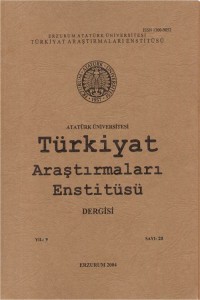YAŞAR KEMAL'İN "YILANI ÖLDÜRSELER" HİKÂYESİ VE ABDULLA KADİRÎ'NİN "ÖTGEN GÜNLER" ROMANLARINDA "SAP AŞK" TEMASI VE KADIN MOTİFİ
Abstract
Bu makalede Özbek ve Türk okuyucuların yakından tanıdıkları Abdulla Kadirl'nin "Ötgen Günler" adlı romanında ve Yaşar Kemal'in "Yılanı Öldürseler" hikayesinde "kadın" motif! ve "aşk" temasının nasıl ifade edildigi karşılaştırılmıştır. Abdulla Kadirl de Yaşar Kemal de kendi eserlerinde birbirine benzer aşkları betimlerken, aşıkların çektigi ıstırapları ve çileleri dile getirmişlerdir. Her iki eserde de kahramanların yaşadıkları aşk hüzünle bitmiş olsa da, her iki yazar da, okuyucuya bu ilişkileri hüzünle neticelendiren sosyal sistemi sorgulatmayı başarmışlardır.
ABSTRACT
From the ancient times Turkish and Uzbek societies are very close to each other, as well as the roots of Literature which are bonded and gives life to a new groves. Looking for the differences and similarities it is worth to compare the "YHani Oldurseler" by Yashar Kemal and Abdulla KADİRİy's "O'tgan Gunler". The show of "Pure Loye" and "Women". Two tragic, breakheart stories in different comers of life but telling about one thing -the power and courage of woman's will, desire in striYing to her Love of iiye. Sure, being not able to pass all the obstacles on their way. So, they blown by Etemity. And only thing remained to them is repelling of the spirits, souls to each other... being so unlucky... So, the authors questions the humanity for cultural strict regulations and rules, the enemies of "Pure Love", "Freedom"...
Keywords
Details
| Primary Language | tr; en |
|---|---|
| Journal Section | Makaleler |
| Authors | |
| Publication Date | February 23, 2010 |
| Published in Issue | Year 2002 Volume: 9 Issue: 20 |

